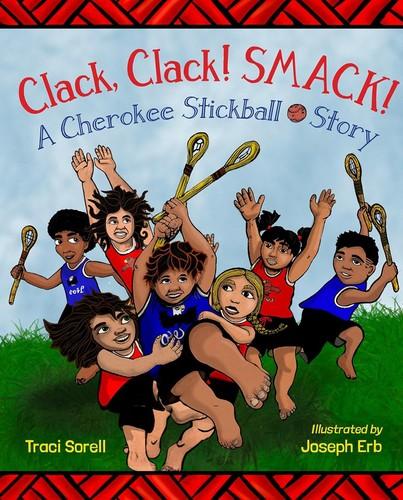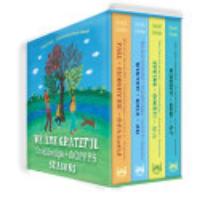Sorell, Traci
9 Reviews
(4)
K-3
Illustrated by
Joseph Erb.
A boy with “a towering body” has trouble keeping up with his teammates in this story about stickball, a popular sport in Cherokee communities that resembles lacrosse and basketball. Despite Vann’s lack of speed, encouragement from his coach and fellow players gives him the confidence to assist in the winning play. Sorrell’s lively text is paired with Erb’s cartoonish digital illustrations with stylized proportions. A glossary of Tsalagi (Cherokee) words and author’s notes about the language and stickball are appended.
Reviewer: Marva Anne Hinton
(2)
K-3
Illustrated by
Michaela Goade.
Caldecott-winning Goade (Tlingit Nation) evokes a unique mood in each book she illustrates. Here she uses gray and dull browns and blues in her mixed-media art to show city scenes, but leafy green to depict the rural ancestral lands of a family's home, to which they are returning. Brilliantly, she employs hot pink as the signature color for the narrator, a girl who happily moves away from the city without looking back ("I'm ready"). In the first pages, that pink appears as a kind of decorative, clashing overlay, as if the girl's imagination is doodling over her nondescript surroundings. As they drive home, though, more warm pink colors appear contextually in flowers, furniture, clothing, food, and the sunset -- the girl blends in naturally with her new environment. The progression of colors matches the spare text by Sorell (Cherokee Nation), which describes the family's change in location as a change in rhythm and tempo: "Singing, / shell shaking, / storytelling, / stickball playing / all offer different beats." This story beautifully captures the joy of returning home and reuniting with family.
(3)
PS
Illustrated by
Frané Lessac.
Sorell and Lessac's picture book We Are Grateful: Otsaliheliga (rev. 11/18) took readers through a Cherokee extended family's year. Now, in this sturdy boxed set of board books, each book focuses on a different season. The family plays in the leaves in Fall / Uligohvsdi, listens to elders tell stories in Winter / Gola, plants a garden in Spring / Gogeyi, and watches Auntie play stickball in Summer / Gogi. The brief (rewritten) text captions Lessac's homey, jewel-toned illustrations (sampled from the original picture book) on chunky pages in a universal, but culturally specific, journey through the year. For other celebrations of heritage from Black and Jewish creators, respectively, explore Your Legacy Begins: First Words to Empower (Abrams Appleseed) by Schele Williams, illustrated by Tonya Engel, and I Like Your Chutzpah: And Other Yiddish Words You'll Like (Rise/Penguin Workshop) by Suzy Ultman.
(2)
K-3
Illustrated by
Arigon Starr.
Baseball's 1911 World Series was the first to feature a match-up between two Native players. Future Hall-of-Fame pitcher Charles Bender (Ojibwe) would pitch in three of the six games, including the decisive sixth, for the Philadelphia Athletics; while hard-hitting catcher John Meyers (Cahuilla) would be behind the plate for the New York Giants for all six games. Both players were nicknamed "Chief" by the racist press and endured insults and slurs throughout their entire professional careers. Sorell (Cherokee Nation) provides readers with biographical sketches of Bender and Meyers, tracing their childhoods and divergent paths to professional baseball before diving back into the game-by-game highlights of the thrilling 1911 championship series. Starr (Kickapoo Tribe of Oklahoma) employs a mix of hand-drawn and digital art throughout and incorporates Ojibwe and Cahuilla designs in the pages relating Bender's and Meyers's childhoods. The art expertly foregrounds the central figures: Bender and Meyers are drawn with detailed texture, setting them apart from the largely flat backgrounds featuring teammates, fans, and reporters. An author's note, a detailed timeline, and a list of sources round out this handsome package, sure to pique the interest of young baseball fans.
Reviewer: Eric Carpenter
| Horn Book Magazine Issue:
March, 2023
(1)
K-3
Illustrated by
Frané Lessac.
In this informational picture book by the team behind We Are Grateful: Otsaliheliga (rev. 11/18), a diverse group of students and families are headed to (the fictional) Native Nations Community School for Indigenous People's Day presentations. Each spread depicts a different student's report on a subject significant to Native people's experience since the late 1800s. Topics include assimilation, allotment, termination, language revival, and more; although these are dense and complex areas, Sorell makes them comprehensible for readers through the book's unique format. Each classmate's "presentation" includes a brief summary or definition ("Assimilation: Most U.S. leaders did not respect our ways and thought it would be better for us to adopt their beliefs and practices") with a handful of supporting details. Every presentation concludes with the line: "We are still here!" Warm gouache illustrations help support the historical context while personalizing the contemporary setting. This book provides information that is omitted from most curricula ("Most people do not know what happened to Native Nations and our citizens after treaty making stopped in 1871") in an easy-to-understand manner. Above all, the message is reinforced for all readers: Native people are still here. Appended with a glossary, a timeline, sources, and an author's note.
Reviewer: Nicholl Denice Montgomery
| Horn Book Magazine Issue:
May, 2021
(2)
K-3
Illustrated by
Natasha Donovan.
Sorell (We Are Still Here!, rev. 5/21) opens the book with a note on four "Cherokee values" that she uses to frame Ross's (1908–2008) long life: "Gaining skills in all areas of life (both within and outside the classroom), working cooperatively with others, remaining humble when others recognize your talents, and helping ensure equal education and opportunity for all." Through realistically cartooned digital illustrations and straightforward text, readers learn how Ross's experiences reflected these traits. Because she valued learning and had a passion for math, Ross was able to persevere when "the boys refused to sit next to the only girl in math class." This passion led her to a job as a mathematician for Lockheed Aircraft Corporation, where she worked with others to design fighter planes as well as spacecraft. Her most important contribution was encouraging other women and American Indians to become engineers. An appended timeline, an author's note, source notes, and a bibliography provide more details about Ross's life and times. Also appended with Sorell's Four Cherokee Values written using Cherokee syllabary and its transliteration; phonetic pronunciation in English; and English-language translation--features that help to preserve the language for future generations.
Reviewer: Nicholl Denice Montgomery
| Horn Book Magazine Issue:
July, 2021
(2)
4-6
It's 1954 and eight-year-old Regina Petit and her family--members of the Umpqua tribe in northern Oregon--are forced by the U.S. government to relocate to Los Angeles. There, Regina tries to adapt, making friends outside her culture and figuring out what it means to be Indian. McManis and Sorell's straightforward, easygoing narrative is shot through with deadpan, subversive humor; this book is distinctive in voice, accessible in style, and told with an insider's particular power (based on McManis's childhood).
Reviewer: Sarah Ellis
| Horn Book Magazine Issue:
November, 2019
(2)
K-3
Illustrated by
Weshoyot Alvitre.
In a cabin at the base of a mountain, multiple generations of Cherokee women await the return of their daughter/sister/mother/granddaughter, who is piloting a plane during wartime somewhere far away. While they wait, they weave, sing, and pray for her safe arrival. Sorell's poetic text is augmented by Alvitre's vivid watercolor and ink illustrations. The book captures the emotions of families separated by war while introducing readers to an often-erased part of history.
(1)
K-3
Illustrated by
Frané Lessac.
An extended family engages with activities and traditions that express gratitude and carry on Cherokee history and culture. Simultaneously, the book incorporates modernity and challenges dated images of Indigenous people. Cheerful, richly detailed gouache illustrations in bright, saturated colors cycle through the seasons. The text includes several Cherokee words (their English and Cherokee spellings, phonetic pronunciation, and definition); a complete Cherokee syllabary concludes this attractive and informative book. Glos.
Reviewer: Julie Hakim Azzam
| Horn Book Magazine Issue:
November, 2018
9 reviews
We are currently offering this content for free. Sign up now to activate your personal profile, where you can save articles for future viewing.













